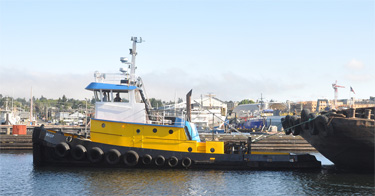Ric and Bob Shrewsbury’s dad started a tug company in 1948. “It was all general towing around Puget Sound,” Ric Shrewsbury explained recently. Four years later the Salmon Bay Sand & Gravel Co. became a client. That firm had a facility on the Lake Washington Ship Canal just up from the locks that bring boats into Lake Union. The company, owned by the Nerdrum family, takes its name from the bay where salmon congregate after coming out of the locks on their journey from the sea through Lake Union and Lake Washington to their natal rivers.
“My dad did the Salmon Bay contract on a handshake with Nerdrum. Now both our companies are moving to the third generation,” Shrewsbury said.
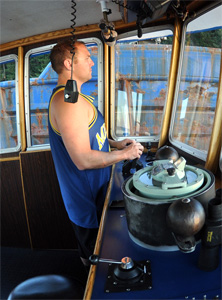 |
|
Capt. Ryan Johnson operates the controls in the towboat’s wheelhouse. |
Under the ownership of the Shrewsbury brothers, Western Towboat has followed the lead set by their father to expand operations into Alaska. They have done much more than expand their towing range. They have built, in their own yard, a fleet of vessels that are among the most modern and powerful ocean towing vessels on the Pacific Coast. This magazine covered the quality of these boats and their role in towing container barges to Alaska in 2007 (PM #102, February/March 2007).
Tows to all parts of Alaska have become the backbone of Western Towboat’s business. “But towing gravel and other products in Puget Sound still makes up between 10 and 15 percent of our business,” Shrewsbury said. The shorter tows in the relatively sheltered waters of Puget Sound serve as a good training ground for new skippers, he pointed out.
Some of the tows are with Western’s own barges but they continue to tow Salmon Bay’s gravel barges as well. At 1130 on a beautiful September day, the 62-by-18-foot tug Wasp made up to Western’s side-wall-fitted flat-deck barge Western Provider. The bridles have evolved for Puget Sound work to use 18 feet of 2-inch Poly-Dac line shackled to 36 feet of 1-inch wire that is, in turn, shackled to an eye on the end of the 1,500-foot-long main towline. This makes it easier and safer for the deck crews to handle while adding a little give to the line when towing.
The 250-by-70-foot barge would have to pass through the 80-foot-wide lock that connects the Lake Washington Ship Canal to Shilshole Bay and Puget Sound. This makes for a tight fit with only five feet on either side. As is the usual practice, Shrewsbury comes out in the little 38-foot, 400-hp single-screw tug Flyer. With a steerable nozzle, this highly maneuverable boat makes a good assist tug. He will tail the barge down the canal and into the locks.
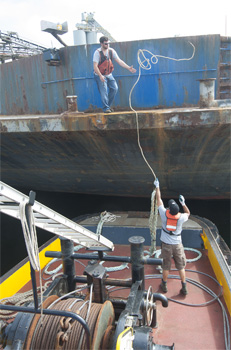 |
|
Deck hand Sajo Sunde throws a line to Joe Bailey, Wasp’s mate, as the men begin making up the tow. |
On board Wasp, Capt. Ryan Johnson is directing mate Joe Bailey, who has climbed onto the barge, and deck hand Sajo Sunde in making up to the barge. With tugs made up fore and aft they move down the narrow canal and under the Ballard Bridge. A 45-foot elevation means the bridge doesn’t have to open for the tow which continues on down past the Fishermen’s Terminal and Salmon Bay to the locks. Shrewsbury and Johnson, who is still on the front of the barge, keep in touch on the radio as the tow enters the lock. Then with the barge secured to the lock wall, Shrewsbury turns back out of the lock and Wasp and its tow are on their own. The lock crews know the Western Towboat people well, especially on the local boats, and so there is time to exchange predictions on various football teams and their players while the water drains and the tow lowers from lake to sea level.
By 1300 the tow is clear of the lock and headed out among the sport fishing boats of Shilshole Bay. Turning south to pass West Point and then, with Elliott Bay and the Seattle Waterfront on the port quarter, a low fog bank masks Seattle with the Space Needle and a few of the tallest buildings showing above. Sport fishing boats and sailboats appear out of the fog bank on their quest for salmon and breezes. Johnson lets out about 500 feet of towline from the single-drum towing winch. The Wasp wheelhouse is designed so that the skipper can step back from the portside jog stick to work a set of winch controls beside the cabin’s back door. This gives good visibility to the towing winch while allowing the master to keep an eye ahead as well. There is virtually no wind in the Sound and with the tow shortened up like this there is still enough wire to allow a good speed. Western Provider is well behaved and follows well with no shearing. At 1,665 rpm on Wasp’s twin 3408 Cats, the tow moves along at a comfortable 7.7 knots with a 150-degree heading on the Sperry autopilot.
At 1330 fog envelops the tow off Alki Point but the afternoon sun soon burns it off. Johnson has gone to get some rest and Bailey has the watch. Vessel Traffic reports that there are no scheduled commercial salmon fisheries on today’s route that will take the vessels about 12 nm down West Pass between Vashon Island and the Olympic Peninsula. This route is a little shorter and avoids the deep-draft vessels coming in and out of Tacoma that use East Pass on the other side of Vashon. At 1540 the tow is abeam the bottom-end of Vashon Island, with Tacoma and Mount Rainier showing up to port.
Ten minutes later Point Defiance is abeam and Wasp enters the 2.5-mile-long Tacoma Narrows. The destination is the Cal-Portland gravel loading dock at Dupont about 10 miles below the bottom end of the Tacoma Narrows. The Narrows are spanned by the twin Tacoma bridges. Tides under the bridges and in the Narrows run at up to 4 knots. With this run scheduled to take advantage of the day’s 3.8-knot flood tide, the tow is soon whipping along at nearly 10 knots. A northbound tug pushing a gravel barge passes red-to-red, then Wasp overtakes Dunlap Towing’s tug Swinomish towing a log boom. At 1600 Wasp passes the log tow and is quickly under the Narrow’s twin bridges.
As the tow approaches the gravel dock at 1700, the captain comes back to the wheelhouse and slows the tow at the request of the dock manager. Another tug and barge are just finishing their loading. Johnson tells of seeing military maneuvers with boats and helicopters from nearby Fort Lewis practicing landings on a beach near the gravel dock. At 1755 the other tow has departed and the barge is secure to the dock and the loading has begun. Sunde climbs in behind the deck winch with an air-powered needle gun to attack some rust. Like all Western’s boats, the maintenance is to a very high level. The crews’ boat pride is only exceeded by that of Bob and Ric Shrewsbury, whose sons and daughters are now working for the company and adding to the tradition.
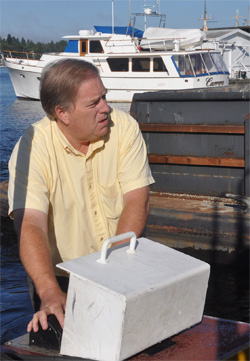 |
|
Ric Shrewsbury, captain and Western Towboat co-owner, at assist tug Hornet’s deck controls. The Shrewsbury family has built one of the most modern ocean towing fleets on the Pacific Coast. |
By 2150 the barge is loaded with about 4,250 tons of various grades of sand and gravel. It is a little under the capacity of 5,500 tons, to allow for seasonally lower water levels alongside the offload dock. Despite being down about 13 inches at the bow, the barge still tows well. With the ebb tide now giving a little push northward, the tug and barge are making 4.5 knots and reach the top end of West Passage by 0245 the following morning. This is despite running at only 900 rpm on the Cats. Bailey is on watch and explains that there is no need to get into Lake Union before 0700 so the reduced speed gives an ETA to Shilshole Bay of 0600 while allowing for significant fuel savings.
As the crew approaches Alki Point, Bailey looks ahead through the darkness. “It’s pretty dark to the north and I can’t see the lights of Seattle,” he said. “Looks like fog,” and then he raps his knuckles on the wooden window frame as he apologizes. “Not suppose to say that word in the wheelhouse.”
But the word is said and the fog settles in thick and opaque around the wheelhouse windows. Bailey steps out on deck to check the running lights and comes back inside to stare into the gray mass for an amber light that the radar shows a short distance ahead on the port bow. Looking aft he can see the barge’s running lights showing strong through the fog and he comments, “Bob takes pride in his running lights.”
At 0340 the fog lifts a little and the amber light shows to port with Alki Point to starboard with the reassuring lights of Seattle behind it. By 0500 the tow, still running easy at about 1,000 rpm and making 3.8 knots, is off West Point and approaching the entrance to Shilshole Bay. The fog has set back hard, swirling in moisture-heavy clouds around the wheelhouse. Vessel Traffic reports a MOL containership coming out of Elliott Bay and Bailey talks with the pilot, a former Western skipper, by radio. The ship will pass astern of the tow as will the tug Protector also coming out of Elliott Bay. Other traffic out there in the fog includes a deep-draft ship heading north and the cruise ship Carnival Miracle coming south, but both out of the critical range of the slow-moving and fog-shrouded tow.
At 0540 the captain is up to prepare the tow for entrance into Shilshole Bay and the locks. The fog is now so thick that even the barge running lights are obscured. Johnson directs Bailey and Sunde to get lines ready to make up to the barge “river-style.” He shortens the tow right up to the stern of the tug so that Bailey can step onto the low front of the barge from the tug’s fantail. The mate removes the rope bridles and the tug swings around to the stern of the barge. Lines are put up through a fairlead on the bow of the tug and run out to the bollards on either side of the barge. A Pullmaster winch on the bow is used to tighten these so that the bow is snug with the barge.
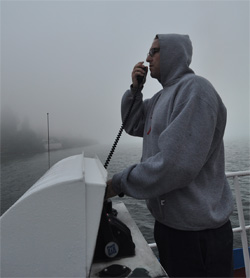 |
|
Positioned at the topside controls, Johnson guides a loaded gravel barge through fog toward a lock to enter the Lake Washington Ship Canal. |
Additional lines are run from the barge’s stern quarter bollards to the stern of the tug. The starboard line is pulled tight and tied off to the bitts on the tug. The port line is shackled to the end of the towline and taken up tight with the Nordic towing winch. While this is happening the tide is pushing the tow toward a buoy marking the south side of the entrance channel. Checking his clearance from the buoy with Bailey on the front of the barge, Johnson uses the twisting power of the twin screws of the tug to swing the barge and then pull it out into the channel. Daylight is piercing the fog and small sport fishing boats show up to add complexity and a little tension to the maneuver.
It is 0645 when Johnson calls the locks to tell them that he is on his way with an overall length of 325 feet. At the same time Shrewsbury calls from the other side of the locks where he awaits Wasp’s arrival. Johnson climbs up to the controls on top of the wheelhouse so that he can better peer over the mountains of gravel on the barge while Bailey directs him by radio from the head of the tow. The red and green channel markers slide by. Finally, with minimal clearance, the barge slides into the lock and is made fast while the gates close and the water fills the chamber.
By 0750 the upper lock doors open and Shrewsbury puts a line up on the front of the barge. There is a noticeable sense of relief in the wheelhouse of Wasp. It is good to know when your boss has taken control of the tow. From there it is a short run up to drop off the barge at the customer’s pier. One of Wasp’s crewmembers is trading places with another and the boat will head back down the ship canal to pick up two barges from Salmon Bay before heading back south to get loads of gravel for them.
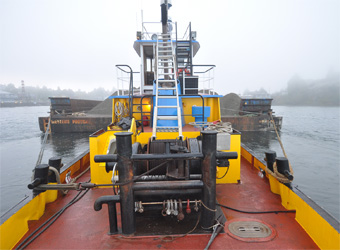 |
|
Wasp made up river-style to push the loaded barge Western Provider. |
Shrewsbury assisted with the loaded barge using Western’s little tug Flyer. For assisting Wasp with the Salmon Bay barges, he switches to the 42-foot, 365-hp Hornet. These are the two smallest boats in Western’s fleet of 21 vessels, including several 120-foot 5,500-hp and 6,000-hp Titan-class tugs, but they get the same loving care and are ready to work at a moment’s notice.
Running down the ship canal after Wasp , Shrewsbury recalls, “We had the Wasp built in 1967 up in Blaine at the yar d that moved to Anacortes and became Dakota Creek. It was an outside boat built as a single-screw tug. I’ve made a trip to Bethel in western Alaska on her and another to San Diego. In the 1970s we converted it to a twin-screw and we have rebuilt the boat several times.”
Western built Western Mariner in 1983 at its own yard and has built another 16 or 18 since. Shrewsbury has lost count. It has another of the big Titan class under construction. Shrewsbury puts a line up to the stern of one of the Salmon Bay barges to pull them off the pier so that Wasp can make up to them. He then tails the tow down to the locks and assists them in. Wishing the crew a good trip, he turns back to Salmon Bay where one more loaded barge needs to be shifted.
All masters of an art make it look easy, and Shrewsbury is no exception. Setting Hornet alongside the loaded barge, he walks around it to lift the mooring lines from the bollards. Returning to the tug, he moves forward and puts a line up to a bollard on the starboard bow. Moving across the deck to the outside controls, he pulls the loaded barge out of the slot in which it was moored then sets it moving forward. He has set the speed of the barge so that once he takes back his line the heavy gravel barge glides into place under the offload crane and is easily stopped by the shore crew tying down the mooring lines.
Ignoring a compliment Shrewsbury smiles and says, “Just another day!” All is well in the Northwest: The Shrewsburys are building another tug and still working the ones that they already own. Their dad’s contract with the Salmon Bay Sand & Gravel Co. is still in place, and the salmon are still jumping in the ship canal.

